Your kids can learn and write about lemurs using the guided writing lessons and activities outlined in this post. It just so happens that I live in the area where the largest population of lemurs in captivity reside, the Duke Lemur Center.
*This post contains affiliate links. For more information, see my disclosures here.*
While on a walk one day, a good friend of mine was telling me about these adorable, energetic, silly creatures native to Madagascar. Just a few weeks prior, she had taught a group of children how to draw a series of lemurs. The classes took place at the Duke Lemur Center here in North Carolina. Later, the center held an auction and actually bought one of the children’s drawings to hang in their facility!
Books
Over the course of many more walks and talks, we learned that the DLC was lacking good sound children’s books that conveyed accurate non-fiction information about lemurs. My friend and I decided to write and publish a non-fiction book about lemurs, using the children’s illustrations. In turn, we sold the book in their gift shop. That book sold in the lemur center for a solid 2 years before I realized it desperately needed an updated 2nd edition….a project that rests patiently at the back of my mind. If you feel so kind, gracious and interested in purchasing the very first edition, you can do so on Amazon*.
Art and Writing Camps
The writing of this book is what gave my friend and I the idea to start art and writing camps at the DLC. The staff there so kindly agreed to partner with us and let us do so! We wanted to give opportunities to children to be authors and illustrators all the while learning about the world and their environment. Part of the partnership is that we incorporate in our lessons accurate information about lemurs and DLC’s mission.
Visit Your Local Lemurs!
Subsequently, these writing camps led to me to start this website, www.funwritingideas.com, where teachers can use the lessons in their own settings. If you have a zoo or facility near you that houses lemurs, I’d strongly encourage you to plan a visit so the children can learn more. Then, use any of the lemur prompts below as a follow up activity!
Fiction Mixed with Facts
Many of the writing prompts that I’ve taught and will be posting are fictional. Some are even entertaining. But, in each lesson, I’ve made it a point to incorporate accurate facts about the specific lemur that we’re focusing on. These Additionally, some lessons focus on the importance of conserving these unique and endangered animals.
An Easy Lemur Art Accent
Now, before I outline the three guided writing lessons about lemurs, I must show you this easy Ring-Tailed lemur art accent. If you’ve spent any time at all on this website, you know that easy art accents motivate children to write and reward them for their work! In addition, they add color and charm to any child’s story.
The Ring-Tailed lemur is, from my experience, the most recognized lemur species among children. Students immediately recognize the black and white striped tail. As a result, I decided to focus on that species when presenting an art accent to my students.

Adding a Ring-Tailed Lemur Art Accent
Bordered Paper
Note, that the students write on lined paper with a border. Here’s a printout of the lined paper I use for Grades 2-7 and Grades K-2. Here’s a printout of a border with no lines to use with very early writers.
Marker
To complete the stink fight art accent, students simply draw two black and white tails coming up from the bottom of their paper. One tail starts at the bottom and “wafts” to the left of the story while the other tail starts at the bottom and “wafts” to the right of the story. Point out to the children that Ring-Tailed Lemurs’ tails always end in black!

Here’s a sample for you to print and hang.
This super simple art accent can go along with the following guided writing lessons, A Stink Fight, Three Little Lemurs and the Big Bad Fossa and Lemurs vs. Lumberjacks. All three writing lessons are outlined below. The two tails “wafting” is especially fitting for the Ring-Tailed Lemurs Stink Fight so let’s start with that one!
3 Writing Lessons
First, before I outline all three guided writing lessons, you’ll want to read my post titled: Guided Writing Lessons for Grades K-5. It helps you gain a full understanding on how I conduct each writing lesson. The lemur writing lessons outlined below (and all other lessons posted) will make more sense and be easier to follow and use. Additionally, here’s the lined paper I use for Grades K-2 and Grades 2-7
Spelling the Word LEMUR
Secondly, I think you’ll appreciate teaching your students how to spell the word lemur. This step is definitely optional. However, I find it very helpful since many children do and will misspell the word lemur. To learn how to spell LEMUR, we sing this short, quick song to the tune of BINGO:
There is a primate that can leap
And LEMUR is its name-o
L-E-M-U-R, L-E-M-U-R, L-E-M-U-R
And LEMUR is its name-o
As silly as it is, it drastically improves the spelling of LEMUR!
Lemur Writing Lesson # 1: A Ring-Tailed Lemur Stink Fight

Now, let’s get to the 3 lemur writing lessons. This first lesson is a big hit! It is a story about two male lemurs stink fighting to win the watching female’s favor. As you may know, Ring-Tailed lemurs are perhaps the most known lemurs. The movie Madagascar and the TV series All Hail King Julian are two popular programs that come to mind starring a Ring-Tailed Lemur.
Who’s really in charge?
Much to the students’ surprise, we learn on the tours at the Duke Lemur Center that FEMALE Ring-Tailed lemurs are in charge, not the males. The females get the best food, best sleeping spots and they choose which male they want for a mate not the other way around. So, the students and I laugh when we hear the show should technically be called, “All Hail Queen Juliana”!
In addition, the way that a female Ring-Tailed lemur chooses her king, is by watching two males stink fight! These two lemurs never touch each other. Instead, they pull their tail between their legs, use the scent glands on their wrists to lather the end of their tail with their stink and waft the smell at the opposing male. They do this over and over again until the weaker lemur walks away. Ultimately, the strong standing stinky lemur gets the queen!
Tell the Story Line
Next, begin this lesson by telling the story line: “We’re going to write a descriptive story about two male Ring-Tailed lemurs stink fighting to win the favor of a female lemur.”
Teach Stink Fighting
Secondly, brainstorm and discuss key facts about the Ring-Tailed lemur and how they actually fight. They:
- live in the spiny forests of Madagascar.
- have scent glands in their wrists.
- stand, bring their tail forward from between their legs and wipe their wrist scent all over the end of their tail.
- “waft” their tail at the opposing male without ever touching him.
At the end, the female chooses the smelliest male to be her mate. In general, lemurs communicate through smell. Their specific scents communicate information about themselves and their troops. So the female is considering the smell seriously when choosing a mate.
When my students write this story, we usually write as if the lemurs are fighting in a boxing ring in the middle of the spiny forest of Madagascar. However, this is an optional detail of the story. Of course, you and your students can decide the exact setting for the fight!
Show the 5 Sections
Third, show the students the five sections of the story:
- Introduce the fight.
- Describe the 2 lemurs.
- Start of the fight.
- Fight
- The female decides
As mentioned in my writing prompts introduction: K-1st Graders are encouraged to write 1 sentence for each section, 2nd Graders 2 sentences, 3rd Graders 3 sentences and so on.
Brainstorm Descriptive Details
Because the information around a stink fight will most likely be new to your students, I suggest discussing and listing descriptive details for each section. This will give students ideas to help them along as they’re writing.
- Introducing the fight: Time of year, Madagascar, spiny forests, a female is set to choose a mate
- Describing the 2 lemurs: Older, younger, bigger, smaller, smarter
- Starting the fight: Scenting the ropes, Moving side to side, Standing up, Bouncing around, Pinning their ears back, High squeaking
- Fighting: Tails arched over their heads, Flicking their tails, Wafting their scent
- The Female Deciding: Chooses the bigger, stronger, smarter, stinkier and/or the weaker lemur walks away.
Now to Write!
Guide students through the following steps. They are free to use their own words. Reminded them that ANYTHING can happen in their story as long as they follow the steps to keep their story organized.
- First, write the introduction naming the time of year or day, the location and the reason for the fight.
- Next, describe the two lemurs ready to fight.
- Then, write the start of the fight in detail, naming the actions of the two lemurs.
- Fourth, describe the fight and their actions in detail. Include what the watching lemurs are doing.
- Lastly, tell the actions of the female lemur, who she decides and how she shows it.
Print the Stink Fight Lesson
Here’s the full lesson for you to print out and use.
GAMES TO PLAY!
You can play any one or all of these writing games after completing the Stink Fight lemur writing lesson.
- Correct the Paragraph
- Sentence Scramblers: (#1 of our Top 5 Writing Games) Use these Lemur Facts to play!
- Silly Sentences: (#2 of our Top 5 Writing Games. Use bounce, waft, squeak and scent in one circle and and students’ words in the 2nd circle.
Lemur Writing Lesson #2: Lemurs vs. Lumberjacks

This particular lemurs writing lesson focuses on conservation. Lemurs are endangered in Madagascar primarily because of deforestation. To convey this message in a story, I decided to conduct a lesson titled, “LEMURS VS. LUMBERJACKS.”
Tell the Story Line
First, tell the story line: “Lemurs are tired of lumberjacks cutting down the trees and ruining their habitat. They plan to fight the lumberjacks and win!”
Brainstorm
Next, brainstorm different qualities of different lemurs and ways that they could “fight” against the lumberjacks!
- Red-ruffed lemurs live at the top of the canopy and love fruit.
- They could “shoot fruit” from above.
- Coquerel sifaka (pronounced “kockril sherfock”) can leap up to 30 feet.
- They could catch the lumberjacks off guard by hopping onto them from far away.
- Ring-tailed lemurs stink fight by rubbing their terrible scent on their tails and wafting the smell.
- Aye-aye lemurs are nocturnal. It is feared for its red eyes and ghostly vocalizations. Additionally, it also a long skinny skeletal middle finger and can poke the lumber jacks’ eyes while they’re sleeping.
Encourage the students to use 2-4 different lemurs in their story.
Show the 5 Sections
-
- Use sounds and introduce the problem
- Lemurs’ Meeting and Play
- 1st lemurs and 2nd lemurs’ plan
- 3rd and 4th lemurs’
- The attack and lemurs’ victory
As mentioned in my writing prompts introduction: K-1st Graders are encouraged to write 1 sentence for each section, 2nd Graders 2 sentences, 3rd Graders 3 sentences and so on.
NOW TO WRITE!
Guide students through the following steps. They are free to use their own words. Reminded them that ANYTHING can happen in their story as long as they follow the steps to keep their story organized. In the printable PDF version below this lesson, there are examples in italics for your own guidance.
- First, begin the story with sounds that are heard using onomatopoeias: Chop! Chop! Chop! Tiiiiiimbeeeeer!
- Second, name the problem.
- Third, write about how the lemurs come together and discuss ideas to fight.
- Fourth, write what the Red-Ruffed lemurs say they will do. Try not to use the word said.
- Fifth, write what the Coquerel Sifakas say they will do. Try not to use the word said.
- Next, write what the Ring-Tailed say they will do. Try not to use the word said.
- Then, write what the Aye-Ayes say they will do. Try not to use the word said.
- Finally, write the ending of the story that assures the lemurs fought and won.
Print the Lesson
In the FREE printable PDF lesson here, I’ve included samples of what the students might write for your own guidance.
Here’s the full lesson for you to print out and use.
Here are several samples from students in Grades K-2
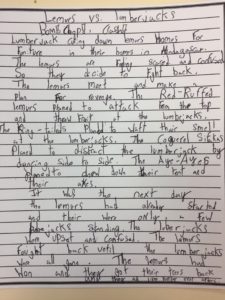
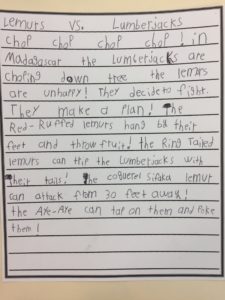
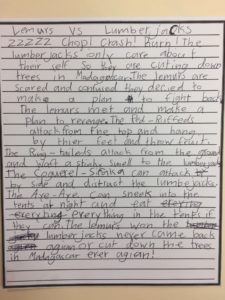
My campers wrote their stories in the book that they authored and illustrated about lemurs. So, the art accent was their actual drawing. For this lemurs writing prompt, students can use markers to draw trees or put tree stickers* in the border. They can write their title with marker or ABC stickers* for a nice finish.
Games to Play
You can play any one or all of these writing games after completing the Lemurs vs. Lumberjacks lemur writing lesson.
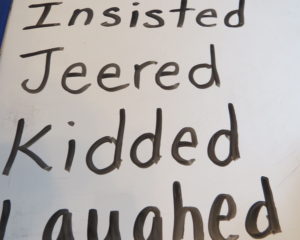
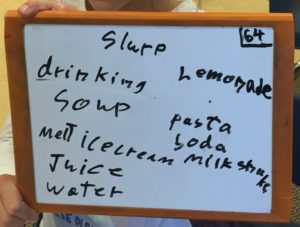
Lemur Writing Lesson #3: Three Little Lemurs and the Big Bad Fossa

The Fossa
This lemur writing lesson focuses on the fossa, which is the lemurs’ main predator. They look like a mix between a mountain lion and a weasel. Most kids have never heard of the fossa and they find it fascinating.
In order to help solidify the campers knew knowledge of the fossa, I thought they’d like writing a fairy tale titled, “The Three Little Lemurs and the Big Bad Fossa”.
Tell the Story Line
First, tell the story line to the students: “You’re going to write a fairy tale about three little lemurs and a big bad fossa. Each lemur will build their own shelter. The third lemur will protect them all from the fossa.”
Brainstorm
Next, teach or discuss a series of facts about lemurs and write them on the board. They:
- -live in Madagascar
- -stay in groups called ‘troops’.
- -love to eat fruit.
- -forage for food. Forage means to look for food.
- -have an opposable thumb. Their hands work like a mitten.
- -are great climbers.
- -communicate through smell, their smells give other lemurs information.
- -can’t hang from their tail but can hang from their hands and feet.
- -use their long tail to balance.
- -live low to the ground, half way up the forest, or in the top canopy of the forest.
- -are mostly are diurnal (awake during the day) while a few are nocturnal (awake at night).
Encourage the students to incorporate at least 3 facts into their fairy tale. Then, brainstorm materials available to the lemurs in the forest, such as Leaves of all sizes, fruit, sticks, bamboo, etc. Last, discuss the elements of a story, which are characters, time, place, problem and solution.
Show the 5 Sections
- Introduction (time, place, characters)
- Problem
- Lemurs Build
- The Fossa
- Solution/Conclusion
Now to write!
Guide the students through the following steps. They arre free to use their own words. Remind them that ANYTHING can happen in their story as long as they follow the steps to keep their story organized. In the printable PDF version below this lesson, there are examples in italics for your own guidance.
Time, Location and Characters
- Begin by naming the time, location and characters.
- Write what their mama said to them. Name the problem.
- Next, write what each lemur builds.
- Fourth, write what the fossa does and says to the lemurs.
- Lastly, write the ending of the story. Tell what happens to the lemurs and the fossa.
Print the Lesson
Here’s the full lesson for you to print out and use.
Games to Play!
You can play any one or all of the following writing games with your students after completing the fairytale lemur writing lesson.

Spelling/Vocabulary-4-11 Words: (#3 of our Top 5 Writing Games)
Use the words lemur and fossa. Both of these words are hard for the students to spell!

Word Scramblers (scrambling Fairy Tale Characters)


*All background knowledge and information needed for these prompts came from the staff and tours at the Duke Lemur Center.*
